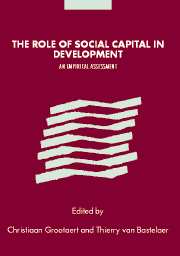Book contents
- Frontmatter
- Contents
- List of figures and maps
- List of tables
- List of boxes
- Notes on contributors
- Acknowledgments
- Foreword by Robert D. Putnam
- Introduction and overview
- Part 1 Social capital at the micro and macro levels: a conceptual discussion and review
- 1 Social capital and poverty: a microeconomic perspective
- 2 Social capital, growth, and poverty: a survey of cross-country evidence
- Part 2 The impact of social capital on development
- Part 3 The creation and transformation of social capital
- Conclusion: measuring impact and drawing policy implications
- Index
- References
2 - Social capital, growth, and poverty: a survey of cross-country evidence
Published online by Cambridge University Press: 22 September 2009
- Frontmatter
- Contents
- List of figures and maps
- List of tables
- List of boxes
- Notes on contributors
- Acknowledgments
- Foreword by Robert D. Putnam
- Introduction and overview
- Part 1 Social capital at the micro and macro levels: a conceptual discussion and review
- 1 Social capital and poverty: a microeconomic perspective
- 2 Social capital, growth, and poverty: a survey of cross-country evidence
- Part 2 The impact of social capital on development
- Part 3 The creation and transformation of social capital
- Conclusion: measuring impact and drawing policy implications
- Index
- References
Summary
This chapter surveys the major contributions to the rapidly growing empirical literature on social capital and economic performance, focusing primarily on cross-country approaches. It first addresses characteristics of governments that fall under broad definitions of the term social capital. It then reviews studies of “civil,” or nongovernmental, social capital.
Most of this literature explores the determinants of growth in per capita income, devoting no attention to distributional effects. This chapter is a preliminary attempt to fill that gap by providing new cross-country evidence on the effects of social capital on poverty and the distribution of income.
This chapter is limited primarily to cross-country studies of social capital and economic performance. It does not attempt to comprehensively review regional-, village-, or individual-level analysis or the expanding literature on social capital's impact on noneconomic outcomes, such as health, education, or crime. Nor does it examine the rapidly growing body of work that explores the determinants of social capital.
Defining social capital
The breadth of the term social capital varies from one researcher to another. In keeping with the scope of the World Bank's Social Capital Initiative, the term is defined broadly here to include features of both government and civil society that facilitate collective action for the mutual benefit of a group, where a group may be as small as a household or as large as a country.
In chapter 1, Collier distinguishes between government social capital and civil social capital.
- Type
- Chapter
- Information
- The Role of Social Capital in DevelopmentAn Empirical Assessment, pp. 42 - 82Publisher: Cambridge University PressPrint publication year: 2002
References
- 40
- Cited by



